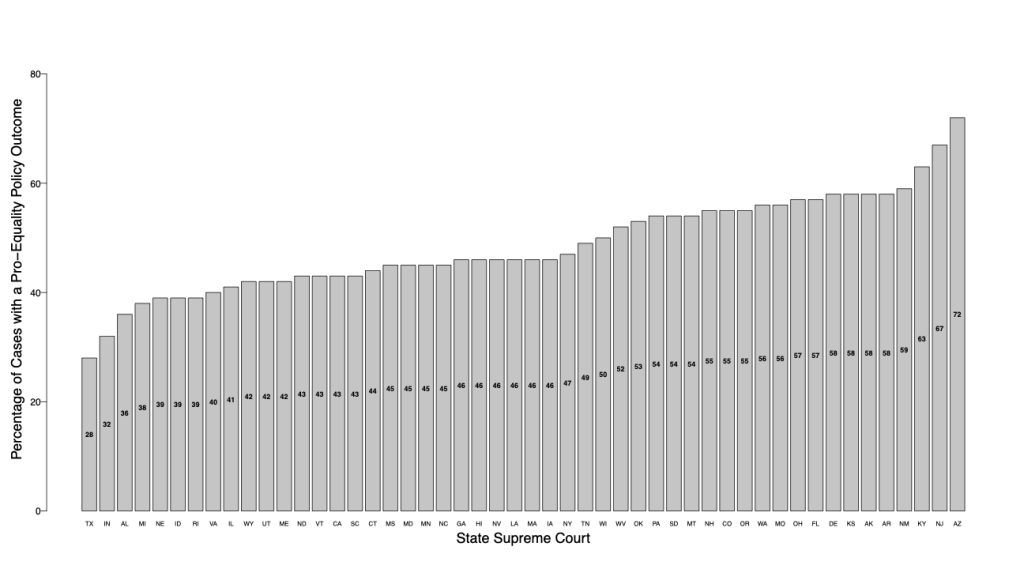I am pleased to welcome to ELB Book Corner James L. Gibson and Michael J. Nelson, authors of the new book, Judging Inequality: State Supreme Courts and the Inequality Crisis. (Readers using this link and the code JUDGING get a 20 percent discount.) Here is their first of three posts:

For the past two decades, social scientists have looked with renewed interest at the problem of inequality in the United States, teaching us that at least some portion of the growing political, legal, economic, and social inequality in the U.S. is a function of the policy decisions made by U.S. political institutions, particularly the executive and legislative branches.
Courts are also powerful and efficacious policymakers, issuing decisions about the boundaries of the government’s ability to regulate the economy and the depth and distribution of citizens’ rights and responsibilities. Yet, with only a few exceptions, we know little about the extent to which the judiciary—at any level of government—has played a role in the inequality crisis in the United States.
While the U.S. Supreme Court issues a declining number of opinions each year, the 52 state supreme courts (Texas and Oklahoma have separate civil and criminal high courts) have the final say on most cases filed in the United States. Indeed, as interest groups recognize, these institutions are incredibly potent and relevant policymakers.
We take up this challenge in Judging Inequality, a new book published recently by the Russell Sage Foundation. With support from the National Science Foundation and the Russell Sage Foundation, we created an original dataset of nearly 37,000 votes in about 6,000 equality-relevant cases decided in the 50 states between 1990 and 2015. We divide the cases into three broad policy domains. First, we code rulings concerning the rights of minorities, including poor people. This issue area involves cases relating to school finance funding equality, gay rights, and election law. Second, the dataset includes cases about the rights of workers and employees, including cases concerning employment at will doctrines and collective bargaining. The final issue area is cases relating to access to the state’s justice instructions. Cases in this issue area involve mandatory arbitration, class action, attorneys’ fees, and damage caps.
The core of our analysis is the 6,000 state supreme court decisions relevant to political, legal, economic, and social inequality. We therefore begin the discussion of our findings with an examination of the outcomes in these cases: do the courts’ rulings advance or slow greater inequality? A team of nearly 50 research assistants read each case and coded them according to the court’s disposition on the merits. In election law, for example, we asked coders whether the court’s decision expanded opportunities for participation. To aid coders, we provided specific exemplars of pro-equality decisions: for example, those that remove barriers to voting (e.g., Voter ID laws), allow initiatives or referenda to be placed on the ballot, lessen the control of political parties over ballot access, and require the disclosure of campaign donors.
Overall, we found that state supreme courts decided cases in pro- and anti-equality directions equally: 47 percent of the cases in our dataset were decided in a pro-equality direction; 53 percent were not. Among election law cases specifically, the gap is slightly larger, but not overwhelming: about 58 percent of the election law cases in our dataset were decided in a pro-equality direction.
Particularly noteworthy is the cross-state variation in pro-equality outcomes, as the figure below illustrates. While most states vary in a band from about 40 percent to 60 percent of their decisions favoring greater equality—a significant range in itself—a handful of state supreme courts stand out as outliers. The Arizona, New Jersey, and Kentucky courts issued an unusually large percentage of pro-equality decisions, while the state supreme courts in seven states issued an unusually low percentage of such decisions. The Texas Supreme Court is the most anti-equality court in the country, followed by the Indiana Supreme Court. Across America, the rights you have depend on where you live.
Figure 1

This figure aggregates outcomes in all equality relevant cases decided between 1990 and 2015.
This research was conducted with the support of the National Science Foundation (SES-1456568 and SES-1456580) and the Russell Sage Foundation (G-1962). Any opinions, findings, and conclusions or recommendations expressed here are the authors’ alone and do not necessarily reflect the views of the National Science Foundation or of the Russell Sage Foundation.